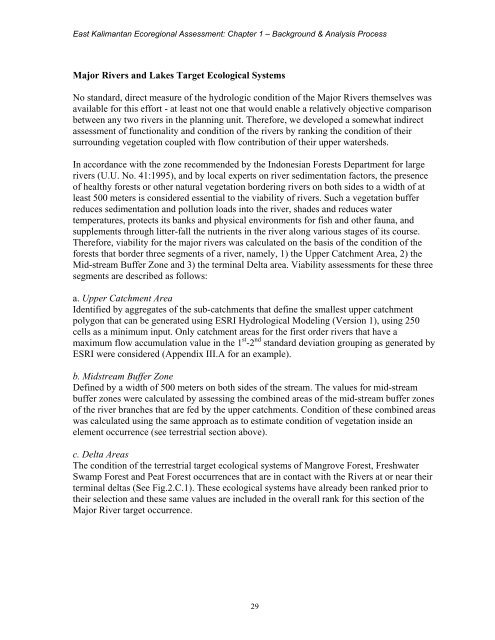Ecoregional Assessment of Biological Diversity in East Kalimantan
Ecoregional Assessment of Biological Diversity in East Kalimantan
Ecoregional Assessment of Biological Diversity in East Kalimantan
Create successful ePaper yourself
Turn your PDF publications into a flip-book with our unique Google optimized e-Paper software.
<strong>East</strong> <strong>Kalimantan</strong> <strong>Ecoregional</strong> <strong>Assessment</strong>: Chapter 1 – Background & Analysis Process<br />
Major Rivers and Lakes Target Ecological Systems<br />
No standard, direct measure <strong>of</strong> the hydrologic condition <strong>of</strong> the Major Rivers themselves was<br />
available for this effort - at least not one that would enable a relatively objective comparison<br />
between any two rivers <strong>in</strong> the plann<strong>in</strong>g unit. Therefore, we developed a somewhat <strong>in</strong>direct<br />
assessment <strong>of</strong> functionality and condition <strong>of</strong> the rivers by rank<strong>in</strong>g the condition <strong>of</strong> their<br />
surround<strong>in</strong>g vegetation coupled with flow contribution <strong>of</strong> their upper watersheds.<br />
In accordance with the zone recommended by the Indonesian Forests Department for large<br />
rivers (U.U. No. 41:1995), and by local experts on river sedimentation factors, the presence<br />
<strong>of</strong> healthy forests or other natural vegetation border<strong>in</strong>g rivers on both sides to a width <strong>of</strong> at<br />
least 500 meters is considered essential to the viability <strong>of</strong> rivers. Such a vegetation buffer<br />
reduces sedimentation and pollution loads <strong>in</strong>to the river, shades and reduces water<br />
temperatures, protects its banks and physical environments for fish and other fauna, and<br />
supplements through litter-fall the nutrients <strong>in</strong> the river along various stages <strong>of</strong> its course.<br />
Therefore, viability for the major rivers was calculated on the basis <strong>of</strong> the condition <strong>of</strong> the<br />
forests that border three segments <strong>of</strong> a river, namely, 1) the Upper Catchment Area, 2) the<br />
Mid-stream Buffer Zone and 3) the term<strong>in</strong>al Delta area. Viability assessments for these three<br />
segments are described as follows:<br />
a. Upper Catchment Area<br />
Identified by aggregates <strong>of</strong> the sub-catchments that def<strong>in</strong>e the smallest upper catchment<br />
polygon that can be generated us<strong>in</strong>g ESRI Hydrological Model<strong>in</strong>g (Version 1), us<strong>in</strong>g 250<br />
cells as a m<strong>in</strong>imum <strong>in</strong>put. Only catchment areas for the first order rivers that have a<br />
maximum flow accumulation value <strong>in</strong> the 1 st -2 nd standard deviation group<strong>in</strong>g as generated by<br />
ESRI were considered (Appendix III.A for an example).<br />
b. Midstream Buffer Zone<br />
Def<strong>in</strong>ed by a width <strong>of</strong> 500 meters on both sides <strong>of</strong> the stream. The values for mid-stream<br />
buffer zones were calculated by assess<strong>in</strong>g the comb<strong>in</strong>ed areas <strong>of</strong> the mid-stream buffer zones<br />
<strong>of</strong> the river branches that are fed by the upper catchments. Condition <strong>of</strong> these comb<strong>in</strong>ed areas<br />
was calculated us<strong>in</strong>g the same approach as to estimate condition <strong>of</strong> vegetation <strong>in</strong>side an<br />
element occurrence (see terrestrial section above).<br />
c. Delta Areas<br />
The condition <strong>of</strong> the terrestrial target ecological systems <strong>of</strong> Mangrove Forest, Freshwater<br />
Swamp Forest and Peat Forest occurrences that are <strong>in</strong> contact with the Rivers at or near their<br />
term<strong>in</strong>al deltas (See Fig.2.C.1). These ecological systems have already been ranked prior to<br />
their selection and these same values are <strong>in</strong>cluded <strong>in</strong> the overall rank for this section <strong>of</strong> the<br />
Major River target occurrence.<br />
29

















